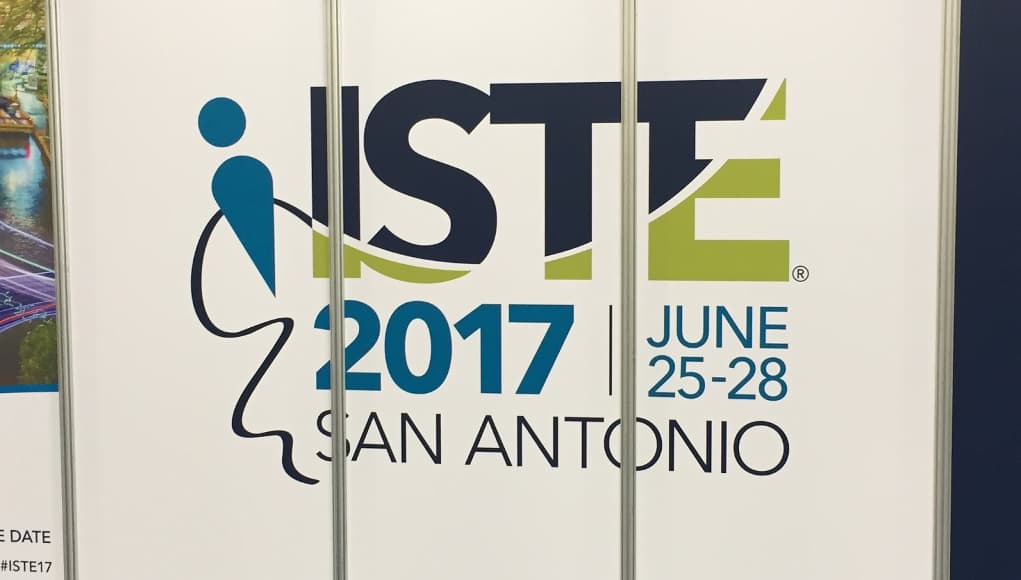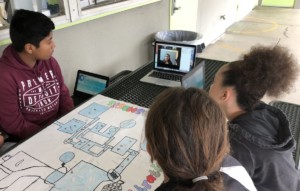10 New & Innovative EdTech Products Announced at ISTE 2017

Another ISTE conference is in the books, and this year’s roundup of new products and ideas announced at the world’s second largest EdTech event didn’t disappoint. From virtual reality to boosting reading engagement, we have compiled a list of the innovative products and tools featured at this year’s conference.
In addition, since technology in classrooms looks very different from almost a decade ago when ISTE last released its standards for teachers, CEO Richard Culatta shared the newly updated ISTE Standards for Educators with this year’s attendees. The Standards are designed to support educators with a framework for learning, teaching and leading amplified by technology:
Without further ado, here are ten EdTech products and tools (in no particular order) revealed at ISTE 2017 that we found intriguing:
1.VR Learn. Veative Labs announced the launch of its VR Learn, the first all-in-one K-12 educational virtual reality (VR) headset. It’s also the first educational VR headset to include a controller and built-in mobile device, eliminating the need for a separate mobile phone.
 Currently available in biology, chemistry, physics and math, modules can be adapted for any language and any curriculum and include 3D models, 360-degree animations, tasks, exercises, simulations and other interactive activities, all complemented by smart analytics and classroom management apps for teachers. Virtual reality is a hot topic right now in education (which Tom predicted back in 2015).
Currently available in biology, chemistry, physics and math, modules can be adapted for any language and any curriculum and include 3D models, 360-degree animations, tasks, exercises, simulations and other interactive activities, all complemented by smart analytics and classroom management apps for teachers. Virtual reality is a hot topic right now in education (which Tom predicted back in 2015).
2. Soundtrap. If you’ve been around our team or our website at all in the past year, you know how much we love a good podcast. (Shameless plug: check out our podcast series of 100+ podcasts with EdLeaders around the nation).
So we were interested in learning more about the new collaborative tool Soundtrap, an online learning tool that enables teachers to follow STEAM curriculum through music and podcasts.
 Participants operate in a secure, closed “Walled Garden” environment protected from the rest of the Internet. Teachers can create and oversee walled-gardened groups for a single class, an entire school, or multiple classes or schools as they collaborate on projects. Developers are currently working to spread the program to new users in 57 countries in the next year so U.S. schools can also collaborate with students around the world.
Participants operate in a secure, closed “Walled Garden” environment protected from the rest of the Internet. Teachers can create and oversee walled-gardened groups for a single class, an entire school, or multiple classes or schools as they collaborate on projects. Developers are currently working to spread the program to new users in 57 countries in the next year so U.S. schools can also collaborate with students around the world.
3. Pi-top OS. Put this company on your must-watch list: Pi-Top has created the first DIY Raspberry Pi powered laptop running its own Operating System: pi-topOS. Developers are also in the process of creating a cloud-based ecosystem to help schools across the world teach computer science more effectively and give all kids access to tools that will teach them the skills they need for the jobs of the future.
Their next goal is to democratize coding software & hardware in schools, offering affordable, easily upgradable products to all, changing STEAM education on a global scale. Here is a short video explaining more about this product and company:
4. Micro:bit Small-Board Computer. The UK-based Micro:bit Educational Foundation announced that the popular BBC micro:bit is now available to schools, clubs and families across the U.S. and Canada. The Foundation’s goal is to put the device into the hands of two million elementary and middle school students in the U.S. and Canada by 2020, in an effort to ensure all children have the opportunity to learn valuable critical thinking and coding skills.
 The micro:bit is a credit card-sized, programmable device that includes 25 LEDs to display simple images and text, two programmable buttons, a variety of sensors and the ability to connect to other devices via Bluetooth. It can be programmed using the popular block-based coding language Scratch (speaking of which, be sure to check out this blog where Mary Ryerse and her son, Luke, reviewed Scratch Coding Cards), or students can also program the device using Microsoft MakeCode, which allows them to switch back and forth between block-based and text-based coding.
The micro:bit is a credit card-sized, programmable device that includes 25 LEDs to display simple images and text, two programmable buttons, a variety of sensors and the ability to connect to other devices via Bluetooth. It can be programmed using the popular block-based coding language Scratch (speaking of which, be sure to check out this blog where Mary Ryerse and her son, Luke, reviewed Scratch Coding Cards), or students can also program the device using Microsoft MakeCode, which allows them to switch back and forth between block-based and text-based coding.
5. STEAM Curricula and Ambassador Program. 3D printing manufacturer XYZPrinting announced its new STEAM curricula built around K-12 Next Generation Science Standards (and further supports the important “doing” of science versus just “knowing” it). The company is offering a complete educational solution including hardware, software and the largest catalogue of 3D printing curriculum currently available. Further courses will be unveiled at the end of this year, alongside a brand new education section on its website.
 In addition to this, XYZprinting is offering schools an opportunity to participate in its ambassador program, where educators can share 3D printing knowledge and innovative ways of how they have successfully utilized 3D printing technology in their classrooms.
In addition to this, XYZprinting is offering schools an opportunity to participate in its ambassador program, where educators can share 3D printing knowledge and innovative ways of how they have successfully utilized 3D printing technology in their classrooms.
6. Augie Robot. To support educators’ use of augmented reality (AR) in STEAM instruction, Pai Technology announced the debut of Augie, its robot that combines augmented reality and coding. With Augie, students learn how to write a programming sequence and gain needed technology skills through the combination of augmented reality and play, creating a unique learning experience.
 Designed for early childhood and elementary grade students, Augie blends research from child development experts with the latest technology. With Augie, students can discover how to code by controlling a range of the robot’s movements, and can use the video function to record their own sounds and movies. Here are five more unexpected benefits to using robotics in the classroom shared by guest blogger and teacher Aaron Maurer.
Designed for early childhood and elementary grade students, Augie blends research from child development experts with the latest technology. With Augie, students can discover how to code by controlling a range of the robot’s movements, and can use the video function to record their own sounds and movies. Here are five more unexpected benefits to using robotics in the classroom shared by guest blogger and teacher Aaron Maurer.
7. Reading Engagement Boost. Newsela, an instructional content platform, unveiled a suite of products designed to address the reading engagement gap. These latest offerings, available this fall, were created from demand by teachers and administrators looking for additional tools to help bridge the gap between how kids engage with modern digital content and how they engage with academic technology at school.
“Our team knows we still face an uphill battle when one out of five students report feeling actively disengaged at school. The vision for this expansion is to have Newsela at the core the classroom. We want to go beyond the textbook and help create an instructional content experience for the digital classroom era,” said Matthew Gross, Newsela Founder and CEO. “You’re also going to see a lot of new features layered on the texts themselves, making them more interactive…all beginning this fall.”
The following three features will be rolling out on the Newsela platform in the fall of 2017:
- Newsela Units (beginning with U.S. History)
- Power Words for vocabulary
- Increased elementary content for younger readers
 8. CollabSpace. This collaborative social website was built and maintained by the Cornell University College of Engineering to support the popular maker movement. It is a free resource where students interested in coding, robotics, autonomous vehicles, rocketry, 3-D printing, sustainability, circuit boards and other technological topics can meet and learn by sharing projects they’re working on, ask other students for suggestions, learn new skills or event get help from Cornell faculty, students and alumni.
8. CollabSpace. This collaborative social website was built and maintained by the Cornell University College of Engineering to support the popular maker movement. It is a free resource where students interested in coding, robotics, autonomous vehicles, rocketry, 3-D printing, sustainability, circuit boards and other technological topics can meet and learn by sharing projects they’re working on, ask other students for suggestions, learn new skills or event get help from Cornell faculty, students and alumni.
Since not every student has access to after-school clubs, friends who like making or mentors, CollabSpace serves as an alternative community that encourages STEM education through making and inspires an academic and professional future in the STEM field.
9. Kahoot! App. This game-based learning platform previewed its new mobile app, bringing the magic of game-based learning outside the classroom. Teachers can use the app to send after-class challenges to students as homework, and learners can continue playing for revision and fun wherever they are.
The mobile app also caters to a growing number of students who are increasingly spending time on their mobile devices, giving them the opportunity for revision, reinforcement and, of course, fun outside the classroom.
10. Renaissance Flow 360. Renaissance launched its new product Renaissance Flow 360, created to connect assessment, instruction and practice in one place to drive student growth and save educators time.
 Renaissance has recently collaborated with the El Paso Independent School District (EPISD) on an implementation of Renaissance Flow 360. “Renaissance Flow 360 is the next step this district is taking on the path to creating an active learning environment for each of our district’s 60,000 students,” said Juan Cabrera, superintendent of EPISD (read more about EPISD’s active learning plan that is powering innovation.)
Renaissance has recently collaborated with the El Paso Independent School District (EPISD) on an implementation of Renaissance Flow 360. “Renaissance Flow 360 is the next step this district is taking on the path to creating an active learning environment for each of our district’s 60,000 students,” said Juan Cabrera, superintendent of EPISD (read more about EPISD’s active learning plan that is powering innovation.)
Did you attend ISTE and/or follow #NotAtISTE on Twitter and see something you think should be added to this list? Tell us about it in the comments below!
For more, see:
- 5 Reasons Your Voice Matters in the ISTE Standards For Students Refresh
- Robots Storm ISTE: 6 Implications
- What ISTE Meant for EdTech Operational Leaders
Stay in-the-know with all things EdTech and innovations in learning by signing up to receive the weekly Smart Update.







Jen Giffen
I also really loved hearing about Symbaloo's new path feature! http://en.support.symbaloo.com/knowledgebase/articles/860379-how-to-build-a-path